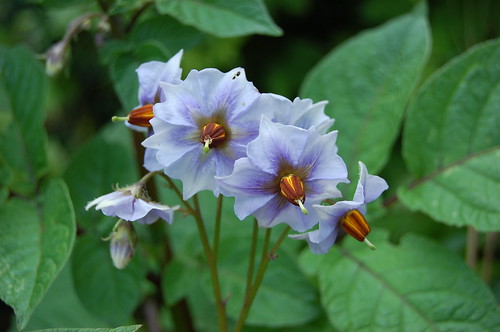
Flowers of Salad Blue, one of the few potato varieties which produces copious quantities of true seed.
I have a very exciting new project underway. My good friend Patrick sent me some true potato seed - generally called TPS - from legendary potato-tomato breeder Tom Wagner. Tom was the founder of TaterMater Seeds in the 1980s, is the creator of the Green Zebra tomato and various others which are now ubiquitous in seed catalogues, and now dispenses his wisdom on the TaterMater messageboard. These potato seeds are from various hybrid and open-pollinated lines in Tom's ongoing breeding work and it's a real privilege to have them.
Not many people grow potatoes from TPS, and there's a few reasons for that. It's not as quick and easy as chucking a few shop-bought tubers in the ground … although the long term rewards are greater. The seeds are not readily available either. I've never seen them for sale anywhere, and you generally have to save your own.
First I should explain what I mean by true seed. When you buy a bag of spuds for planting, they are normally sold as seed potatoes. But it's a bit of a misnomer really. A seed potato (i.e. a tuber) is a root cutting - or clone to use the US term - of the original plant. Tubers are genetically identical to each other, as they only reproduce by mitosis - that is, they are a vegetative extension of the parent plant. Although spontaneous mutations can and do happen, they're uncommon enough that you are pretty much assured of getting a harvest that exactly matches the tuber you planted.
TPS is not the tuber, but the actual seeds - which come from the plant's flowers and fruits. As seeds are produced by sexual means, a coming together of egg and pollen from different flowers or different plants, they represent a genetic recombination. In other words, they are not genetically identical to the parent plant. They are newly created individuals.
If you sow these seeds they will grow into unique new potato plants, and produce their own tubers. The tubers will be small the first year, and will need to be replanted the following season to produce decent sized yields. So it takes two years, but then you go on growing it from tubers as you would any normal potato, and you effectively have a new variety. Potatoes raised from true seed are generally free of virus and disease (at least for the first couple of years).
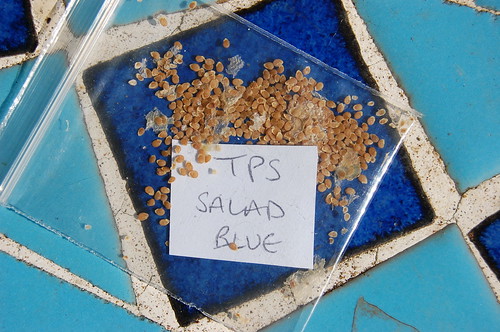
True potato seed, extracted from the berries of Salad Blue. The seeds look rather like tomato seeds, but smaller and smoother.
Potato varieties don't come true from seed, so you never know exactly what you're going to get. Conventional wisdom has it that any plant that doesn't come true from seed is not worth sowing. But to me, and probably most people reading this blog, the unpredictability is exactly what makes it interesting! Even if you sow seeds which were self-pollinated, you can end up with a lot of variation.
A lot of people don't realise that potatoes produce fruits, for the very good reason that most of them don't. Domesticated potatoes have got so used to reproducing through root cuttings - tubers - that they can't be arsed to make viable flowers any more. Some don't flower at all, while some make flowers with sterile pollen, and the flowers just drop off. But every now and then you will find plants which set berries. It's mostly a variety thing, although environmental factors also play a big part. The berries look like small green tomatoes, sometimes with a blush of blue or purple. Some potato varieties produce berries very freely. Salad Blue (pictured above) is a prolific and reliable berry bearer. As is Mayan Gold below.
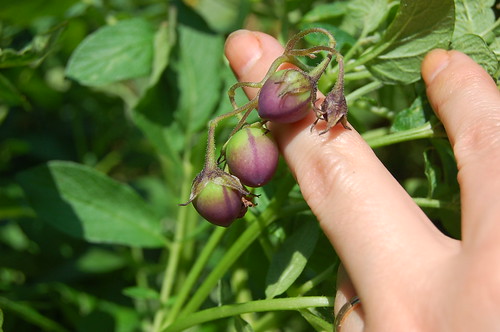
Potato berries on Mayan Gold. This variety is a hybrid of Solanum phureja, a little different from yer common or garden spud, which is Solanum tuberosum. The berries are slightly strawberry shaped - indicating that this species is diploid - whereas most potato berries are more rounded, but the same principles apply.
I'll leave the explanation of extracting and saving TPS for another post, as there are no berries around at this time of year. I will also hold off giving a more detailed genetic explanation, as I'm still on a learning curve with that myself. But what I should explain, briefly, is the reason potatoes grown from TPS are potentially so variable.
The cells of most plants (and humans for that matter) have pairs of chromosomes, in which each gene is inherited in a simple either/or relationship. This arrangement is known as diploid. When a diploid organism reproduces, each parent contributes a single chromosome, and the two join together to make a new chromosome pair. Somewhere along the line, nature had a bit of a freakout with potatoes. Instead of reducing down to one chromosome per parent, an unreduced pair of chromosomes managed to get it together with another unreduced pair. The result is a tetraploid - an organism with four chromosomes instead of the usual two. This basically means it contains two complete genomes - and twice as much genetic material.
Most of the potatoes we know and love today are tetraploid. Although it's a freak of nature, it's quite a beneficial one as tetraploids tend to be bigger and more perfectly formed than their diploid equivalents. If you're interested in how it works and why it's useful, I recommend the Polyploidy Portal for a readable explanation. For the benefit of this post however, I'm going to simplify it to its most basic level. When you make crosses with a 'normal' diploid species, the potential genetic recombination at each allele is very like what you would get if you toss two coins. Plenty good enough for some interesting combinations. With potatoes, however, it's more like the effect of tossing four coins. An exponential increase in the number of possible outcomes. This is why potatoes are so variable when grown from true seed! It's a genetic pile-up bursting with magical possibility.
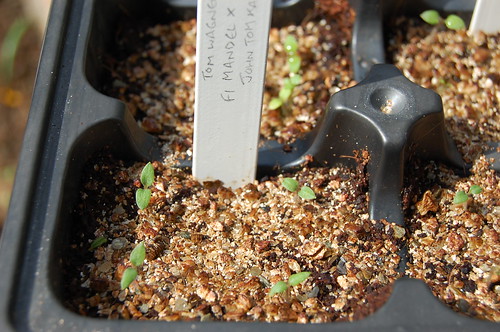
TPS seedlings from Tom's seeds. These are an F1 hybrid between Mandel, a Swedish potato renowned for its flavour, and Tom's own variety John Tom Kaighin, which has been bred for flavour and blight resistance. Neither of these varieties is readily available in the UK. There is a good chance of some excellent flavoured spuds from these seeds, most likely with yellow skin and yellow flesh, and some fingerling types.
How to sow TPS
When Tom Wagner visited the UK last year he gave a lot of advice about how to grow potatoes from TPS. Much of this was captured in a series of videos which you can watch or download on Patrick's blog. What I'm attempting to do here is distil some of Tom's basic instructions into text form - but you can find a lot more detail (including a demo of how to extract the seeds from the berries) in Patrick's videos.
TPS can be sown in spring from mid-March onwards, in any kind of tray or module, and any kind of seed compost. It doesn't need to be a deep module. In this respect, TPS is the opposite of peas. I sow my peas in deep containers so that they produce a deep root run. With potatoes that isn't what you want, because the aim is not to produce lots of root under the seed, but to earth up the young plant as it grows and encourage it to produce roots along the stem. So effectively, you are encouraging the roots to develop upwards rather than downwards!
Potato seeds are small, and so are the emerging seedlings. So you don't want to bury them too deeply. Sow them thinly on the surface of the compost and either press them in or give them a very light covering. I used vermiculite to cover mine, as it helps to keep them moist. Even then I used only a tiny sprinkling, and scooped out the very fine, dusty vermiculite from the bottom of the bag where there are fewer big chunks.
Once you have sown the seeds, keep them warm and damp. As with all small seeds, it's safest to water them by lightly spraying the surface of the compost or using a very fine rose on a watering can. If you're not careful you can wash the seeds away. You can put the tray in a polythene bag or under clingfilm to keep the moisture in, but Tom doesn't recommend this as it increases the likelihood of mould forming on the compost.
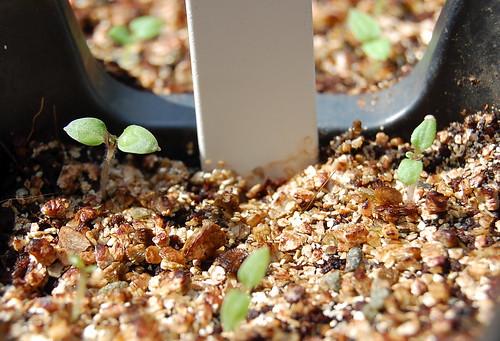
Another of Tom's hybrids which I'm growing at the moment. This is an F3 from Pirampo x Khuchi Akita. These are Bolivian landraces whose tubers look quite different from modern conventional potatoes … in fact I've never seen anything like them in Europe, so I'm very excited by the possible diversity in this hybrid. Pirampo is pink, and Khuchi Akita is purple skinned and crescent-shaped. Tom made this cross to introduce a bit of historic diversity into the potato genepool. The parent landraces are diploid, but can be crossed with other potato varieties to make tetraploids with lots of diversity.
Most of the seedlings will germinate in 5-10 days. But it's not necessarily a bad sign if they take longer. Like tomatoes, they can be fickle about germinating, and will pop up when they decide the time is right - sometimes weeks after sowing.
If you're used to the big chunky shoots that potatoes produce when grown from tubers, you may be surprised - alarmed even - at how small and delicate the TPS seedlings are when they emerge. Although they look similar to tomato seedlings, they are significantly smaller. Have faith - they will grow!
Something else they have in common with tomatoes (and peppers) is seed husk retention. Some seedlings emerge with the seed husk still clamped over their heads. You don't need to worry about this though, because potato seed husks are paper thin, and much less of a problem than the tougher tomato and pepper husks. As tiny as the seedlings are, they will soon tear their way out of their helmets without any need of human intervention.
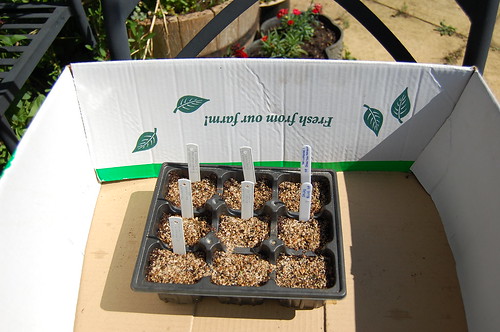
My tray of potato seedlings enjoying a bit of outdoor sunbathing. As they are still young and delicate, I put them in a box to keep the wind off them.
One piece of advice that Tom wanted to make very clear is the importance of sunlight on the young seedlings - by which he meant direct outdoor sunlight and not a greenhouse or sunny windowsill. The reason for this is that potatoes evolved in a part of the world where light is very intense and the air very thin, and so they are dependent on the ultraviolet light that can only be got from direct exposure. If there's a day when the sun is shining (and of course that is a big 'if' in the United Kingdom, but never mind) it's worth putting the potato seedlings outside in the sun, even just for a couple of hours. That way, they develop into strong sturdy plants rather than stretching out and going leggy. However they are still quite delicate at this early stage in their life cycle so you need to stop the spring winds from blowing across them. Placing the seed tray in a larger box, as shown above, should give them the protection they need while still allowing them to sunbathe in the open. If the weather is rubbish when the seedlings emerge, well, there's not a lot you can do about that, but it's a case of making the most of whatever sunlight there is.
I'm going to deal with transplanting in a later post, when my plants reach the appropriate stage and I can take some photographs. In the mean time, I can grow them in these modules until they're a couple of inches tall. The principle of transplanting is the same as that for tomatoes … they benefit from being transplanted at least twice and being buried up to the top set of leaves each time. Because potatoes, like tomatoes, are very efficient at producing feeding roots along their stems. This is, of course, why tuber-grown potatoes are earthed up as they grow. Although the TPS seedlings are tiny, the earthing up method is still the most effective way to grow them.
More anon.
Looking to grow a potato variety that is available in the UK and likely to set berries?
This list is based on a quick search of the European Cultivated Potato Database, but don't rely on it too much. The ECPD takes its data from available research - but you may find differences when you grow the spuds in your garden!
If you want a good chance of berries, try these varieties:
Cara
Desiree
Marfona
Maris Bard
Maris Piper
Mayan Gold
Pentland Dell
Salad Blue
Valor
34 comments:
I was so excited to read this entry! I had a potato plant make fruits last year and I saved the seeds. Most articles I've read said that saving potato seeds is worthless. Pshaw! Your explanation of the 4 chromosomes just blew my mind. I can't wait to see what grows!
It's a shame you missed Tom's masterclass last Autumn.
Tom's given me some spuds to grow and harvest any berries that are produced.
So next year I will be following your lead and trying growing spuds from seed :)
No doubt I'll be returning to read all your careful detailed posts on this topic!
Fascinating stuff Rebsie! I love to see new projects on garden blogs! I suppose most experienced potato growers just pinch off the flowers anyway to divert energy into the roots so we never get to see the fruits. I remember my Sarpo Axona last year had the most flowers I have ever seen!
Great post. Your blog is so fascinating!
I have my second generation from Salad Blue in the ground. I saved the tubers from a true seed sowing (in the fridge salad drawer!) and now have one of each of my 2 favourites in tubs and the rest in a row of each in the allotment. Considering that the Salad Blues were unlikely to be crossed, the variability was considerable. All had some blue colouring but they varied from almost black to creamy with a purple centre.
I found that steaming them in their skins kept the clour beautifully vibrant.
You're going to have fun with these!
Thank you everyone, the comments are much appreciated. Pomly, I'm so glad you found it useful and I'd be interested to hear how you get on.
Matron, yes indeed, from a commercial grower's point of view, the less energy 'wasted' on flowers and berries the better. But it's a very restrictive path because the berries are where the diversity and future potential lies.
Kath, you are well ahead of me on this and I shall be learning what I can from you. My Salad Blue seeds were also open pollinated and although some crossing is possible (there were others flowering at the same time) it's likely that they were selfed and sibbed. From what I've read, there is some possibility of inbreeding depression from OP seeds but so far my Salad Blue seedlings are all looking very vigorous. I love Salad Blue and am very excited about the possible diversity it offers.
Another variety that produces lots of fruit, in my experience, is Shetland Black. Interesting that Mayan Gold (don't they mean Incan?) produced so many fruits My phurejas, although floriferous and beautiful, totally failed to produce any fruit.
Rebsie, that was one of the points Tom made in Oxford. The first trait he always selects for, above all else, is the plants ability to produce TPS. Without this, there is no next generation and no further breeding possible.
I think it's UVB that is blocked by glass, whereas UVA passes through. My oca seedlings go all spindly when they don't get direct sunlight, just like your potatoes. High altitudes increase UV radiation, so that at 4000m it's about 25% stronger than at sea level . No wonder those seedlings crave sunlight.
Patrick - that does make a lot of sense. While it's sometimes possible to force recalcitrant spuds to set berries by thwarting their tuber production, a non-berrying variety is essentially a genetic dead-end.
Owen - thanks for the heads up on Shetland Black. I have grown it and it flowered for me, but then the blight visited. After I reviewed the variety I was contacted by a kind gentleman in Shetland who said the commercial Shetland Black is not the same as the ones the crofters grow. He sent me some tubers and they certainly are different - more rounded, with deeper eyes and without the "netted" surface. I need to blog about them - and find out whether they want to set berries.
Thank you for the explanation of UV differences. I was just repeating what Tom said and didn't know the reasons behind it - always good to get a better understanding of these things.
I have a few seeds from the Mayan Gold berries, and if you have any wish to play with phurejas I'd be happy to share them with you.
Great that you're back blogging, Rebsie - I missed you and wondered how your projects were going!
I too was inspired by Tom Wagner's TPS workshops (via video, thanks to Patrick) and hauled out some 15 year old seed from my Blue Shetland TPS project. Wow, they nearly all germinated, and are now ready to be transplanted into bigger pots. I'll post about it on my blog, but anyway, it'll be fun to watch your parallel project!!
Rebsie, where did you get those beautiful blue Tiles from in the photo?Are they French perhaps? Can you let me know the name of them or the stockist? Great Blog by the way.
T
Wow, that's really exciting! We're growing Cara this year ... I wonder if they will berry.
I've just spent a few hours reading through your blog archive. I came in part way through and it's very interesting to watch you learning as you go. A great encouragement!
Thanks Leigh - I will be very interested to follow your progress with Shetland Blue!
Telegraph Tea Rooms - the tiles are actually part of a table-top, which I believe I purchased from my local Homebase store about four years ago.
Allotment blogger - from what I've heard about Cara, you have an excellent chance of getting some berries. Good luck.
Kath - awww, I'm honoured that you spent the time to trawl through. Yes indeed, I am simply learning as I go along and would probably be very embarrassed if I went back and read some of my early posts now! I did write an earlier post about TPS but my seedlings died after my cat (who was then a kitten) jumped up and knocked them off a windowsill. So this is still all a big learning experience for me.
Hi there - I used to read your blog but have only just rediscovered it. Delighted to see you're still there!
Fascinating to read about the seed potatoes. I'd wondered what the "berry"-like things were last year and never thought of course they might be seed heads! Will definitely try to keep some seeds this year!
Great blog, i've just saved seed from some Maris Piper I grew this year and plan to give this a go in the spring.
The information here has been invaluable, thanks!
Any tips on how to extract the seed would be great as I just squeezed the fruit and both the seeds and the pulp have dried out on a plate.
great blog :D
I've seen someone in Switzerland does some work like Tom.
Sadly his page is very small at the moment but he seems to offer TPS and seed potatoes of his varieties that set lots of berries.
Check it out: http://www.kartoffelsaatgut.ch/
I have fruit on my Blue Danube so i have saved some seed and am going to give it a go next year.
This blog is great! I came here after finding I had some seed balls on my potatoes this year (Rocket I think they were) and being curious. It sounds fascinating!
Have I got this right? If I want to be sure of growing e.g. Rocket variety then I need to grow my spuds from Rocket tubers? And if I plant some of the seeds from the seed balls that I have then each seed could grow into a different variety of potato even though they came from the same plant originally?!
What's the best way of obtaining the seeds from the fruits so they are in a fit state to be planted?
Very fascinating! I was given some supermarket potatoes to grow, but they're not heirloom, and after reading your very informative blogs, I don't want to plant them at all! I want TPS!
I wanted to try to grow from seed this year so I planted last year in hopes of getting some seed. I got NONE. Not a single one! I can't find anyplace on the web in the USA to get any seed to try now! Booo Hooo!
24/24 artificial sunlight (special lamp!) plus constant bottom heat (from horse shit stove) works fine for my Sarpo Una seedlings. I've just planted 80 of them into the field.
i am a student and willing to give a demonstration on the nursery raising and transplanting of TPS please provide me some more information about the technique in north indian climate....regards
i am a student and willing to give a demonstration on the nursery raising and transplanting of TPS please provide me some more information about the technique in north indian climate....regards
I've collected a few tiny tubers( size of a quarter) from a plant grown from TPS, now I'm trying to figure out how to store them to plant next year. Suggestions? Currently I have them in a pot of soil in the garage. The plant was in a large pot and was killed by frost a few days ago, I wish I brought it inside. I live in Boulder Colorado. Our average last frost is may 10th.
Thanks for sharing your views with us. We have gone through your whole article and got excellent information. If you want to buy any kind of seeds
then you can visit to our website which is provided below.
namdhari seeds
solomon bayer
rasi seeds
syngenta seeds
Coin Casino - casinowithbonuscodes.com
Casino No Deposit Bonus Codes. Find the 인카지노 best no deposit 카지노사이트 casino bonus codes in the UK, and get free spins, no deposit 메리트카지노총판 casino bonuses for
Found you via Pinterest. Glad I learn new knowledge about growing potatoes.
Thank you for sharing this information.
I'm glad that I came across your post.
Great post with informative content.
Thanks for sharing.
Post a Comment